Conflict between widllife and livestock grazing
Mongolia’s livestock number has reached over 60 mln leading to enormous overgrazing pressure on grazing land, land desertification, and decline in livelihoods of herders and local communities in the country. Also, in many areas, there are growing conflicts between wildlife and livestock affecting many threatened species.

In Khurkh and Khuiten River Valleys, the number of horse and cattle roaming through the marshes pose serious risks to nesting birds including rare cranes. Because the livestock disturbances cause increased nest site abandonment, it presents one of the greatest challenges for conservation. In addition, livestock grazing can effectively remove top vegetation cover causing an increase in soil temperature which leads to loss of moisture in the active layer.

Researchers using GPS tracking technology to understand livestock movement and grazing intensity in the area. Animals carrying GPS tracking devices will help biologists to document areas most vulnerable to livestock trampling and vulnerable to overgrazing. Data and knowledge generated from this research will help the land managers, herder families, and government agencies to make better livestock grazing management decisions.
